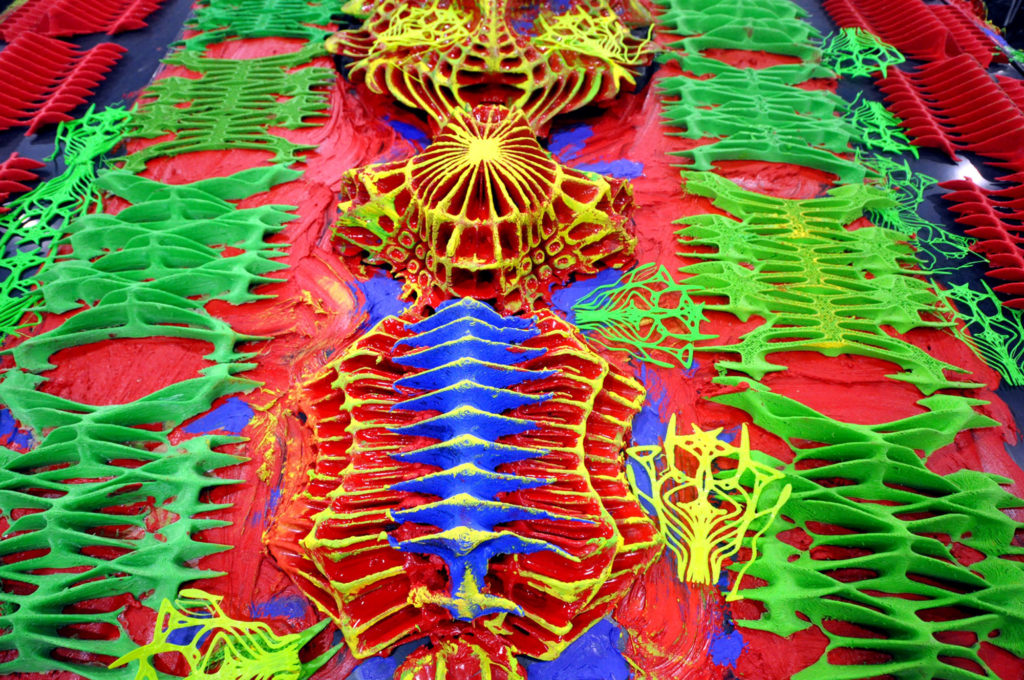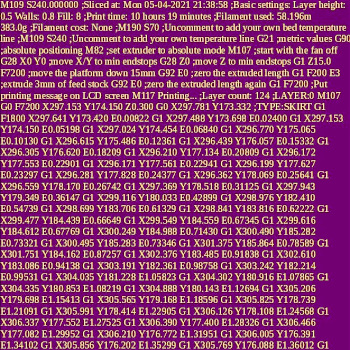Every day we are continually reminded: non fungible tokens (NFTs) are here. One day, it’s the person from the “Disaster Girl meme” minting a JPG of the image she appeared in nearly 20 years ago. The next, it’s a comedic rapper selling an NFT GIF from his 2010 song “Lemme Smang It”. Everydays: the First 5000 Days, the first purely NFT artwork to be offered by a major auction house, sold for $69.3 million.
The digital items that can be linked to a unit of data and stored on a digital ledger (a blockchain), thus rendering them unique and not interchangeable, is seemingly limitless. They range from collectible sports clips and digital land titles in video games to songs, films, pornography and even NBA contracts. In our world, artist Ioan Florea has created what may be the first NFT of 3D printing-related art.

3D Printed Camaro hood Parametric design Symmetric Exoskeleton 65 inches x 60 inches. Image courtesy of Ioan Florea.
Florea has taken digital images of the G-code used to 3D print the structures for his massive sculptural works, the Ford Torino and Chevy Camaro. Both of these projects involve producing geometrically complex accoutrements that were post-processed with metal or fluorescent finishes and attached to their respective vehicles. Now, it’s possible to purchase NFT-backed digital images of the G-code behind these shapes.
“This opens up a dialog about the complexity of 3D printed NFT that includes the actual image, the STL, OBJ or 3MF format and the G-code,” said a press release from the artist.

A copy of an NFT-minted image of the G-code needed to 3D print Ioan Florea’s art. Image courtesy of Ioan Florea.
The dialogue about this relationship could go further to ask the question: are NFTs worth it? As noted in our series on degrowth, our ongoing ecological collapse is in large part driven by a global society that is operating on unsustainable methods of production and consumption. In turn, degrowthers typically advocate for a controlled shrinking of the economies of industrialized societies to more sustainable levels, often by eliminating or replacing existing practices that are ecologically destructive.
While determining which practices these are and how to replace them would be difficult in many ways, NFT-backed items seem like an easy choice for elimination based on their ecological impact alone. Though there is some discrepancy about the accounting behind the estimates of cryptocurrency, it seems that, at the present moment, their overall negative effect on greenhouse gas emissions is undeniable.
NFTs work by essentially creating a digital signature for a file by making an entry into the digital ledger that is a blockchain. Those selling NFT-minted works are also typically paid in cryptocurrency, which can be converted to cash based on the fluctuating rate of exchange of that currency. The most prominent currency for NFT art is Ether, on the NFT artwork exchange called Ethereum.
The carbon footprint associated with NFT minting is somewhere around 85kg CO2. That is about 14 times the size of mailing an art print, around 2.3kg CO2, according to Quartz, or 74, 000 VISA transactions. These emissions derive in large part from the fact that Ethereum, Bitcoin, and other blockchains rely on Proof-of-Work (PoW), a much more inefficient alternative to the newer Proof-of-State (PoS) verification method. Whereas PoW methods rely on huge amounts of computing power, PoS does not and, in turn, reduces energy consumption significantly.
The PoS blockchain Tezos claims that the annual energy consumption of its blockchain totals around 0.00006Twh, about the amount a continuously running escalator at an airport might use annually. This compares to 49.16 Twh for Ethereum, about the amount of energy used by Peru in a year. For this reason, Ethereum is in the process of shifting over to a PoS system, with one Ethereum researcher claiming that this new version will be live sometime this year.
While about 39 percent of PoW mining is performed using renewable energy, that doesn’t mean that renewable energy does not have its own ties to existing natural resources and the environment that are impacted with increased energy use. Given the fact that demand for cobalt for electric batteries is expected to outstrip supply significantly, it’s important to acknowledge that resources are already scarce.
In this case, I would argue that NFTs are not worth the energy they use and they are just one of many aspects of industrialized society that can be done away with as we deal with a climate disrupted world. Then again, if all cryptocurrencies could be made so efficient using PoS that they outperform fiat money, credit cards, etc., then there’s a possibility that crypto would be the way to go.
It may be impossible to slice up the energy usage pie and then regulate away the industries that waste the most on the least significant applications, such as, say, the advertising sector. However, it is something that will need to be introduced into the discourse if we plan to seriously address ecological collapse, which isn’t caused by global warming alone, but extensive resource use more generally. Scientists are now arguing that our entire socioeconomic system is need of an overhaul if we are to stave off the worst impacts of industrial civilization on its ecosystem. So, while I’d probably still be fine with getting rid of NFTs, maybe it’s not the crypto that’s the problem, but everything that built and includes the crypto that has to go.
Subscribe to Our Email Newsletter
Stay up-to-date on all the latest news from the 3D printing industry and receive information and offers from third party vendors.
You May Also Like
Further Understanding of 3D Printing Design at ADDITIV Design World
ADDITIV is back once again! This time, the virtual platform for additive manufacturing will be holding the first-ever edition of ADDITIV Design World on May 23rd from 9:00 AM –...
3D Printer Maker EVO-tech Reborn as NEVO3D — Once More With Feeling
EVO-tech was a 3D printing service and original equipment manufacturer established in 2013 and based in Schörfling am Attersee, Austria. The company produced high-quality material extrusion systems featuring linear bearings,...
3D Systems Brings 3D Printed PEEK Cranial Implant to the U.S. with FDA Clearance
For more than 10 years, 3D Systems (NYSE:DDD) has worked hand-in-hand with surgeons to plan over 150,000 patient-specific cases, and develop more than two million instruments and implants from its...
CDFAM Returns to Berlin for Second Annual Symposium
The second CDFAM Computational Design Symposium is scheduled for May 7-8, 2024, in Berlin, and will convene leading experts in computational design across all scales. Building upon the first event...

































